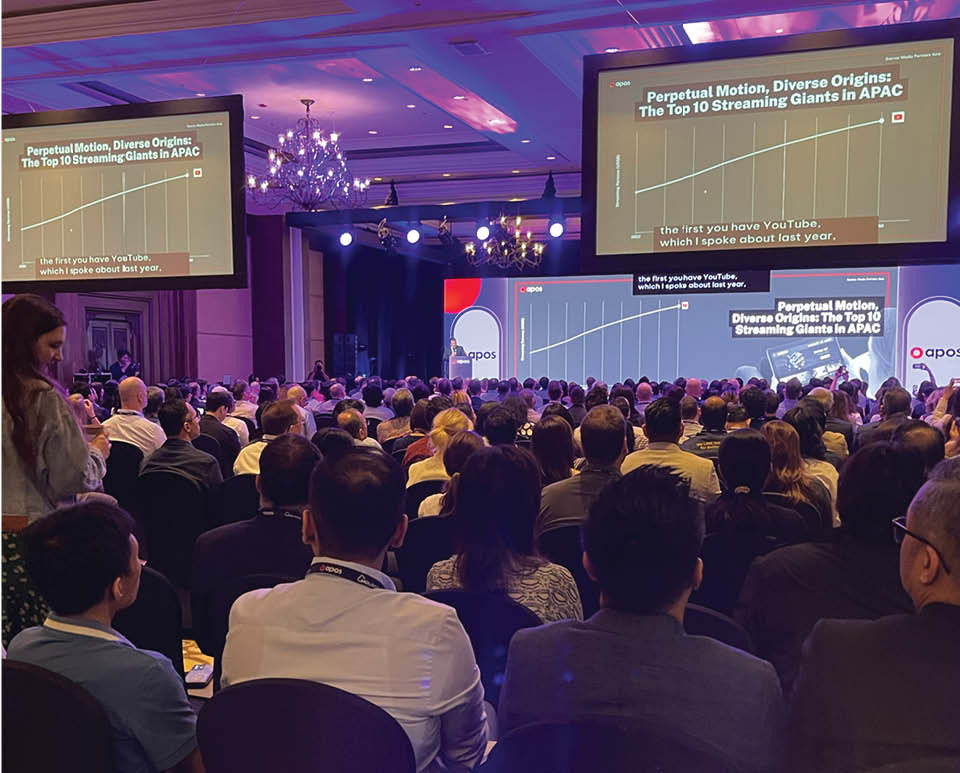
APOS 2025 kicks off...
"The future is not just about scale. It's also how about convergence between UGC and social, video, premium, VOD, retail media, and how all these things with AI come together to define a new growth plan," Media Partners Asia's (MPA) executive director Vivek Couto said this morning as he opened this year's APOS convention in Bali.
More than 550 people gathered this morning to hear Couto talk about the next wave in Asia. "And it looks very different," he said.
Asia-Pacific continues to drive global screen growth with 4.5 billion screens today growing to 5.5 billion in five years time.
CTV is the fastest-growing segment – 13% CAGR, hitting 360 million homes by 2030. 40% of all TVs will be connected by 2030 and ex-China and India most of the region is well above 50%, Couto said in his trademark state of the industry address.
Smartphones remain the largest base, rising from 3.6 billion to 4.4 billion, anchoring consumption across every format.
By region, China and India dominate screen scale, accounting for 72% of total screens by 2030. Total screens are growing fastest in Indonesia, followed by the Philippines and Thailand.
Talking about revenue shifts from 2025 to 2030, Couto said that "as we look at the APAC revenue pie, which grows to US$175 billion by 2030, TV still holds the lion’s share today with 49%. But its share falls to 41% by 2030."
Premium VOD, including SVOD, grows to 29%, driven by subscriptions and hybrid tiers with advertising. UGC and social video rises to 24%, as platforms scale personalisation and creator ecosystems Theatrical revenue is flat, important, but no longer a growth engine.
"Monetixation therefore vis shifting decisively toward digital," Couto said.
Charting the flow of new dollars, he called the pandemic-era boom "exceptional", with US$36 billion in new revenue from 2020–25; "Now, we expect only US$16 billion from 2025–30, largely due to legacy TV erosion."
Advertising growth remained healthy, driven by digital. At the same time, subscription growth "slows sharply as streaming’s substantial growth is o...
APOS 2025 kicks off...
"The future is not just about scale. It's also how about convergence between UGC and social, video, premium, VOD, retail media, and how all these things with AI come together to define a new growth plan," Media Partners Asia's (MPA) executive director Vivek Couto said this morning as he opened this year's APOS convention in Bali.
More than 550 people gathered this morning to hear Couto talk about the next wave in Asia. "And it looks very different," he said.
Asia-Pacific continues to drive global screen growth with 4.5 billion screens today growing to 5.5 billion in five years time.
CTV is the fastest-growing segment – 13% CAGR, hitting 360 million homes by 2030. 40% of all TVs will be connected by 2030 and ex-China and India most of the region is well above 50%, Couto said in his trademark state of the industry address.
Smartphones remain the largest base, rising from 3.6 billion to 4.4 billion, anchoring consumption across every format.
By region, China and India dominate screen scale, accounting for 72% of total screens by 2030. Total screens are growing fastest in Indonesia, followed by the Philippines and Thailand.
Talking about revenue shifts from 2025 to 2030, Couto said that "as we look at the APAC revenue pie, which grows to US$175 billion by 2030, TV still holds the lion’s share today with 49%. But its share falls to 41% by 2030."
Premium VOD, including SVOD, grows to 29%, driven by subscriptions and hybrid tiers with advertising. UGC and social video rises to 24%, as platforms scale personalisation and creator ecosystems Theatrical revenue is flat, important, but no longer a growth engine.
"Monetixation therefore vis shifting decisively toward digital," Couto said.
Charting the flow of new dollars, he called the pandemic-era boom "exceptional", with US$36 billion in new revenue from 2020–25; "Now, we expect only US$16 billion from 2025–30, largely due to legacy TV erosion."
Advertising growth remained healthy, driven by digital. At the same time, subscription growth "slows sharply as streaming’s substantial growth is offset by pay-TV’s inexorable decline".
"The bar is higher. Every dollar will be harder to win. We are entering a tougher, more competitive monetisation phase where growth must be earned," Couto said.
Scale belonged to China, Japan, India, which will command close to 74% of revenues by 2030.
"But their DNA is distinct + their monetisation models differ dramatically in the journey to 2030," Couto said.
In China, short videos, micro dramas and steady but very mature premium VOD, are all underpinned by transactions and ads
In Japan is characterised by premium, still TV-centric, with high ARPU SVOD and a fast growing premium AVOD category, powered by TVer.
India is all about dual engine of ads and value-conscious subscription across streaming and TV with mobile, local OTT, and hybrid models scaling simultaneously.
"Growth across the screen entertainment business belongs to India and Indonesia with total growth weighed down in the transition to streaming from legacy TV," Couto said.
"By 2030, UGC / Social Video is #1 by monetisation in Indonesia and Thailand. Premium VOD dominates in Australia and will continue to do so," he added.
"In Japan and in Korea, TV will still lead but in most top markets, digital has overtaken traditional TV and that shift is irreversible."
Couto labelled his the region's total video revenue market share as "Traditional Strength, New Evolution".
"Let’s pause and look at the market share today, who holds the biggest revenue positions in total video. YouTube is of course large by monetisation share in many markets while Netflix also has growing importance. But you’ll see something important: many of the top players are multi-screen incumbents, from TV to streaming," he said, namechecking Foxtel and Nine in Australia, JioStar in India, TBS and Nippon TV in Japan, and CJ ENM and TVING in Korea.
"These are legacy platforms that have adapted, evolving from broadcast or cable to streaming, live sports, hybrid models. Therefore, the new video economy isn’t just digital-native: it’s cross-platform. Legacy players with transformation strategies can win and prosper," he said.
New dollars flowing into video across Asia Pacific are being shaped by three growth pillars: UGC/Social Video, SVOD, and Premium AVOD, amid shifting traditional TV economics.
"China is rebounding strongly, with UGC and SVOD driving US$3.9 billion in new revenues despite TV erosion. India leads with US$4.8 billion, powered by mass-scale SVOD and monetising AVOD and a resilient TV sector. Japan sees a US$2.4 billion lift as SVOD offsets Pay-TV pressure. Southeast Asia delivers balanced US$1.7 billion growth across digital primarily. Korea adds US$1.1 billion, led by SVOD traction and expanding social video monetisation."
"Much of the growth we have spoken about is being fueled by growth in the creator economy. Creators now dominate audience time, cultural impact, and commerce activation.
"Platforms like YouTube, TikTok, Instagram, and even Facebook Reels are scaling discovery and monetisation.
"But the story is particularly explosive in APAC where there are more than 100 million today and expected to grow to close to 165 million in 2030," Couto said.
In China, Douyin and Bilibili creators monetise across short video, e-commerce and livestreaming. In India, the creator economy is multiplying across multiple languages, boosted by short video, regional OTTs, and commerce tie-ins. In Southeast Asia, creators are culturally embedded, from branded content to live selling.
"As creators rise and revenue pressures mount, premium content investment is getting sharper... The era of overspending is over."
"We’re seeing more focused content, led by sports, local stories, and IP with global appeal with US$17 Billion in premium VOD content investment, growing to US$21 billion by 2021.
"Platforms are now asking: What drives retention? What monetizes? What helps build a marketplace? Premium content is still critical, but the economics now demand precision along with ambition."
More to come...


























